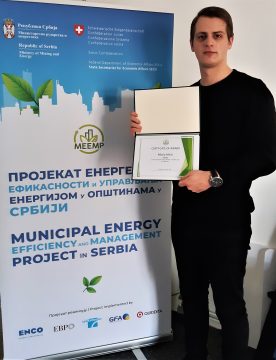
Under the MEEMP, our four Serbian partner municipalities and cities of Krusevac, Paracin, Uzice and Vrbas are implementing the European Energy Award (EEA) as national pioneers. Since the start of the project in 2018, the Energy Management System EEA has been carefully tailored to the Serbian context and a national EEA system is being prepared: The European Energy Award in Serbia (EEAS). Through a nation-wide design competition, the new logo of the EEAS has been developed. The competition invited creative students across Serbia to reflect and communicate the EEAS’ mission and bring in their own vision of a sustainable energy future. The new logo design was created by Mr. Nikola Minić, student of the Faculty of Architecture of the University of Belgrade and selected by a Jury consisting of representatives of MoME, SECO and the Standing Conference of Towns and Municipalities. In the following interview, Nikola Minić talks about his motivation to participate in the competition and his personal hopes for the future.
- What was the main inspiration, idea and principle behind your design?
The concept of the logo is based on the idea of the unique role of the city as an urban space that required systematic and coordinated action towards creating sustainable development and increasing energy efficiency. It is necessary to raise people’s awareness on climate change and to think globally and act locally. The elements of the logo are an abstract representation of an urban environment as the primary motif, and a semicircular line that frames the city.
- What was your first thought when you read that we’re searching for the best logo for the “European Energy Award in Serbia”?
When I read the competition announcement for the conceptual design of the EEAS logo, the first thought I had was that the direct involvement of young people in the process of creating a healthy environment is essential for the future of the planet and the environment in which we live. The burden of solving current and future problems remains with the new generations, and my conceptual design of the EEAS logo represents my modest contribution to this struggle.
- What was your personal motivation to apply?
Aware of the environment in which we live, the motivation was to actively participate and deal with topics related to energy efficiency. This is not my first encounter with this complex of issues, but it represents an enhancement of my previous work and commitment in the fields of environmental protection and sustainable development.
- Did you have support from your faculty (professors, mentors etc.) while developing the logo design?
Regarding the concrete development process of the logo’s conceptual design, I’ve produced everything completely independently. However, I think it is important to emphasize that the Faculty of Architecture of the University of Belgrade has been addressing and implementing concepts of sustainable development for a long time in the context of teaching and extracurricular activities, and I had the opportunity to deal with the topic sustainability within the scope of my studio projects and optional classes. For example, in a studio project called “Sustainable Urban Communities”, where I was under the supervision of the mentor Mrs. Jelena Zivkovic, Ph.D., and worked on a project that revolved around sustainability and environmental efficiency. So through academic engagement at the faculty, my horizons on this topic have broadened.
- What are your first associations with the topics “energy efficiency” and “sustainable energy policy”? Do you think the support that the EEAS is delivering to Serbian municipalities is going into a good direction?
The negative consequences of people’s general behavior towards the environment are often very visible and can be found all around us. All mitigation actions taken, no matter how small or large, are cumulatively a step towards a healthier environment – from well managed waste disposal, to raising citizens’ awareness of eco-friendly behavior, etc.. Linking and coordinating such actions within an Energy Management System is, in my opinion, a sustainable energy policy. As for energy efficiency itself, the first and most important idea is to optimize the use of available resources in every aspect of human activities. In this respect, the support that the EEAS provides to Serbian municipalities is positive and goes in a good direction.
- The younger generations – which you are part of – are mostly affected by climate change and its impacts. Do you have the impression that local authorities should be motivated by (young) citizens to commit themselves to sustainable energy policy implementation?
The younger generations are definitely in an unfavorable position when it comes to climate change, and it is upon us to exert as much influence as possible to solve the challenges and problems in the fastest and most efficient way. The conceptual and executive responsibility undoubtedly lies with the local institutions, so it is crucial to draw their attention to what we consider important.
- Your logo will be widely recognized as the visual “face” of the EEAS and will join the international EEA logo “family” with the logos of all European Energy Award countries. How do you feel about it?
The inclusion of my logo design in the family of national logos of a large platform at European level is a kind of manifesto of my commitment – a confirmation of my attitudes and views towards the world.
Being the winner of this competition is a flattering title that influences and stimulates me for further work on the same and similar topics, and it also represents the new level of responsibility on sustainability and energy efficiency topics that I’ve assumed.
